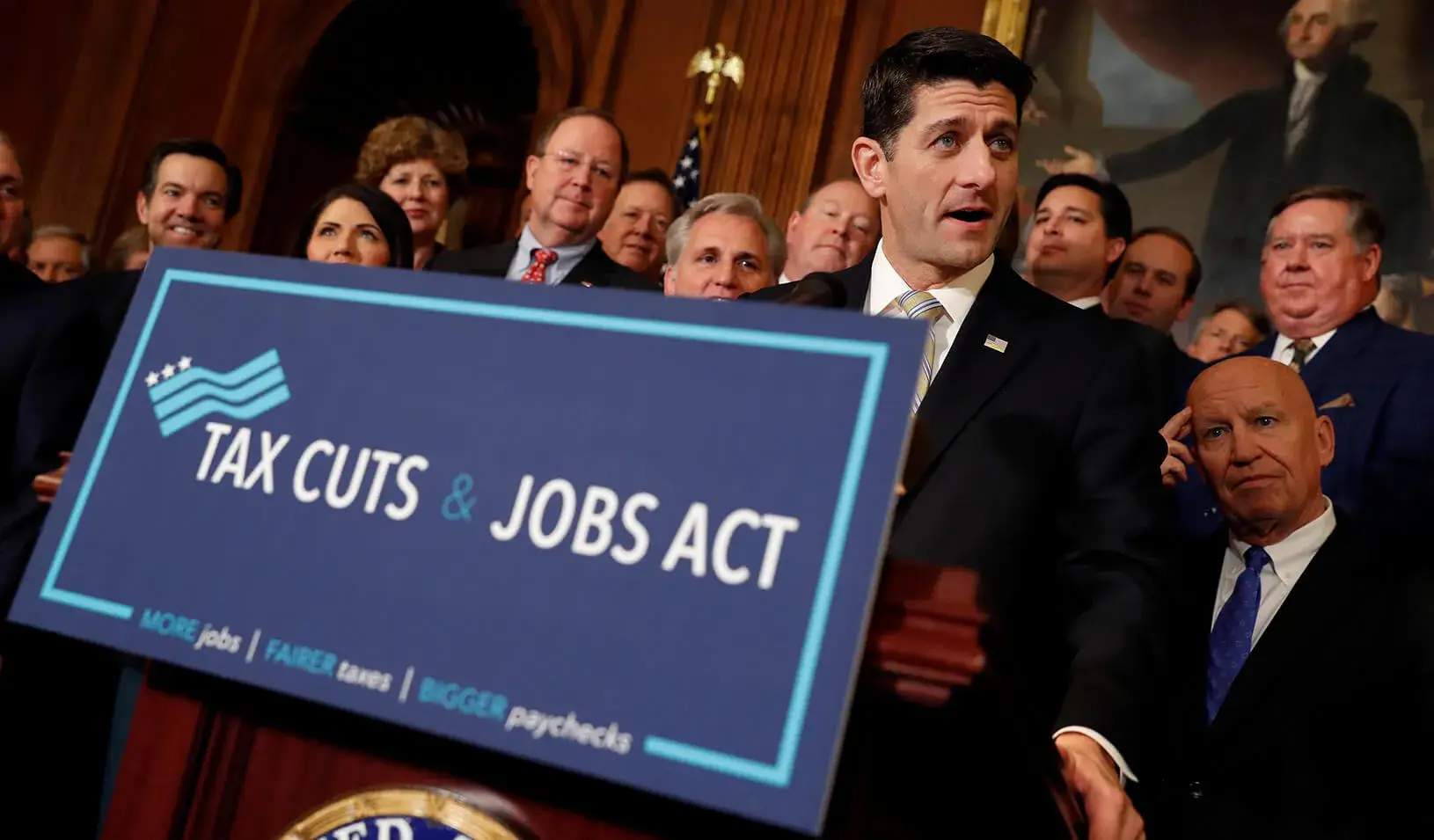The Mixed Impact of U.S. Corporate Tax Cuts
Slashing business taxes brings some local investment but fewer overall U.S. jobs, new research finds.
October 28, 2019

Tax cuts make for splashy headlines, but do they actually help the U.S. economy? | Reuters/Aaron P. Bernstein
When Congress introduced the Tax Cuts and Jobs Act of 2017, President Trump described it as a first step toward “slashing business taxes so employers can create jobs, raise wages, and dominate their competition around the world.”
Ensuing debate over how effectively the bill would achieve these ends — more jobs, better wages, global domination — broke, unsurprisingly, along party lines. Democrat Nancy Pelosi called it a “monumental, brazen theft from the American middle class and from every person who aspires to reach it.” Republican Paul Ryan saw things differently. “Today, we are giving the people of this country their money back,” he said when the bill passed.
A new paper by Rebecca Lester, associate professor of accounting at Stanford Graduate School of Business, offers a more unbiased forecast on what might fairly be expected from this tax cut. Looking at the corporate side of things, she asks: When given lower taxes, do firms actually create more jobs? Do they invest more in the U.S.?
In the end, her results don’t fit a political soundbite: Lower taxes can, indeed, encourage investment in the U.S., but a sizable share of corporate investment actually lands beyond U.S. borders. Furthermore, the U.S. investment appears to be tied to automation, as it is not accompanied by job growth.
Finding Prologue in the Past
Prior to graduate school, as a tax consultant at Deloitte, Lester watched the 2004 rollout of the Domestic Production Activities Deduction, which provided a tax deduction, increasing over time, for manufacturing and production companies. Critically, the law did not require proof that companies applying for the deduction had manufactured more in the U.S. or hired more domestic workers. Instead, companies that earned “production income” as defined by the law could qualify for what amounted to a tax cut on this income.
“This incentive provided a perfect setting for what might happen when there would be a broader reduction in the corporate tax rate,” Lester says. Because some companies were eligible for the deduction under the DPAD — while others, because of technicalities in the statute, were not — Lester essentially had a treatment and control group to test how companies respond to tax cuts. “I could observe whether the change motivated these DPAD companies to invest and hire in the U.S. compared to a baseline.”
From an accounting perspective, several other outcomes were also possible. Companies could have, for instance, shifted transactions in time simply to capitalize on the DPAD. These actions would be less expensive than concretely changing operations. Lester did see firms using this strategy, but she also found two promising effects.
More Money and Investment, in a Limited Way
First, as a result of the DPAD, some firms reclassified a portion of their foreign income as domestic. Specifically, at its peak, when the DPAD offered the equivalent of a 3.15% reduction in taxes on qualifying income, firms retained an additional $20 million of reported income stateside. This brings numerical clarity to “a big debate right now,” Lester says. Will a lower tax rate actually encourage multinational companies to keep money in the U.S.? “Given these findings, under the new tax law we should see more income getting taxed domestically than we did before.”
Second, the DPAD led to greater investment in the U.S. Between 2010 and 2013, four years when the largest deductions were on offer, companies that could take advantage of the DPAD invested an average of $143 million more dollars in the U.S. than companies that could not.
But each of these findings is bound by important limitations. In the first case, companies only shifted their reported income from other countries into the U.S. if the DPAD actually brought the tax rate below what they paid in those other countries. Companies didn’t, for instance, move money out of lower-tax jurisdictions if the U.S. corporate tax rate wasn’t competitive even with the DPAD in place. “There was a huge group of firms that didn’t reclassify income at all,” Lester says. “But, for a subset of companies, the U.S. still got a little bit more than it did before.”
In the case of reinvestment, Lester’s results demonstrated that only firms with no international operations reinvested their DPAD savings in the U.S. And, perhaps more important, “greater domestic investment was not accompanied by greater jobs,” she says. The money that companies invested in the U.S. seemed to go toward automation, thus reducing employment. “The rhetoric related to recent tax policies suggests that these two things should move in the same direction: With greater domestic investment, there should be more domestic employees,” she says. “I observed the opposite.”
Furthermore, multinational firms instead sank tax savings into foreign operations. High-profile examples of multinational companies claiming tax incentives and then reducing domestic jobs — GM, Harley-Davidson — have recently been in the news.
Rhetoric Versus Reality
There is truth to the claim that lower corporate tax rates will bring more money into the U.S., but this is tempered by another truth: The investment this money brings may ultimately reduce overall domestic employment.
“As a citizen of the U.S., of course I wish that companies would invest and employ more in this country. Unfortunately, the results I have are pretty stark about how U.S. tax incentives can affect domestic jobs,” Lester says. At the end of the day, companies invest and employ workers in places that make sense for them — where it is practical and cheapest. The U.S. is not always that place. “Given the recent tax bill, I believe this offers a pretty compelling prediction for what’ll see over the next few years.”
For media inquiries, visit the Newsroom.
Explore More

Tax Avoidance Has Become a Key Part of IPO Planning

Where Insider Trading Flourishes



